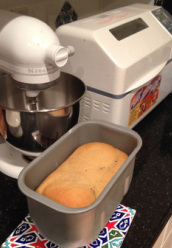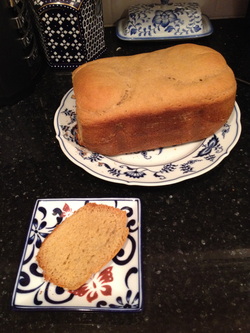
After eating gluten-free for over four years, I believe that the bread of my past is the hardest food to replicate gluten-free. You can’t knead bread dough that has no gluten. Instead, it is the consistency of cake batter. Therefore, it requires a bread machine. And oh, I swore I would never use one of those. Why would anyone want to put ingredients into a machine and miss out on the wonderful kneading and shaping that is (or was) an integral part of the bread-making experience?
But after trying the gluten-free store-bought varieties of bread that tasted like cardboard and had warnings about how I must stand near my toaster as they might incinerate, I had to do something. The first thing I did was to omit bread from my diet—not muffins or scones, but bread. It became easier to do over time. No longer was a slice of bread or a bagel needed to accompany my salad. And if I really wanted something like bread, there was always cornbread or biscuits. Sandwiches became a thing of the past. Who really needed them anyway? My corned beef could be spread with hot mustard and wrapped around Swiss cheese. I could eat pancakes instead of French toast.
I tried baking “breads” that were sorry substitutes for wheat bread; they barely rose, and their texture was wrong, not the soft, springy bread that I craved. And then I bought a book that literally changed my bread-baking life: 125 Best Gluten-free Bread Machine Recipes, by Donna Washburn and Heather Butt. And that meant I needed a bread machine that could tackle the somewhat more tricky business of baking a gluten-free product. After much research, I decided on a Zojirushi, and I have been thrilled with the way this product performs.

(Note: This recipe requires a bread machine; to avoid contamination, use a new and dedicated gluten-free machine.)
1 cup sorghum flour
3/4 cup amaranth flour
3/4 cup cornmeal
1/4 cup quinoa flour
1/2 cup arrowroot starch or tapioca starch
1/3 cup brown sugar
1 tablespoon xanthan gum
3/4 teaspoon bread machine yeast
1 and 1/2 teaspoons salt
1 and 1/4 cups water, warm (about 110 degrees)
2 tablespoons vegetable oil
1 teaspoon cider vinegar
2 eggs, lightly beaten
2 egg whites, lightly beaten
Whisk together sorghum flour, cornmeal, amaranth flour, quinoa flour, arrowroot starch, brown sugar, xanthan gum, yeast, and salt. Set aside.
Pour warm (not hot) water, oil, cider vinegar, egg whites, and whole eggs into bread machine, and turn on for “wheat dough” or “dough” cycle. (This is a one-hour and 50-minute cycle on my machine.) In about 22 minutes, when machine starts mixing, add dry ingredients. Use a rubber spatula to ensure all parts get wet; work quickly and then lower lid.
When cycle finishes (approximately 1 hour and 50 minutes later), turn on bake cycle for 1 hour. (For my machine, I had to create a one-hour custom bake cycle.) After baking, check with an instant read thermometer to be sure that bread center has reached 200 degrees. If not, continue baking or close lid to continue cooking. Allow to cool a few minutes in the pan; run rubber spatula along sides, and turn out to continue cooling. Yield: 1 standard-sized loaf.
Bread freezes well if cut when cool into slices, frozen in an airtight container. It works well for everything from a sandwich to French toast or regular toast and jam.
***
When this loaf finished baking, I quickly sliced the heel and spread it liberally with butter. The texture was perfect. I enjoyed my gluten-free bread perhaps even more than I did my wheat bread. After all, I’d waited years for a good loaf of bread, so I appreciated every morsel.

 RSS Feed
RSS Feed
